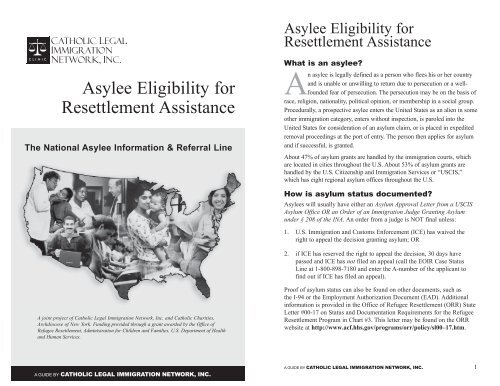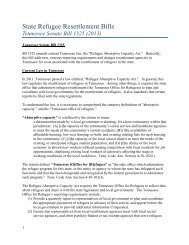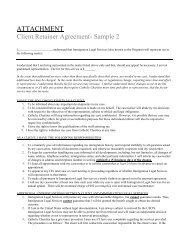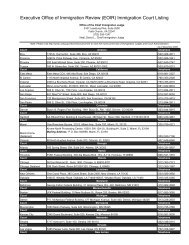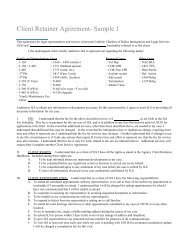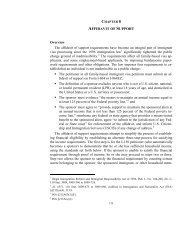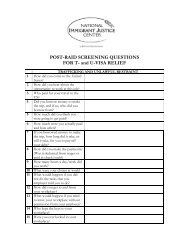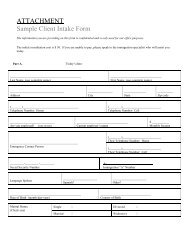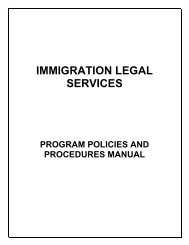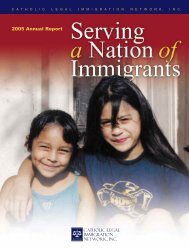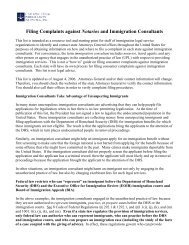Asylee Eligibility for Resettlement Assistance - Catholic Legal ...
Asylee Eligibility for Resettlement Assistance - Catholic Legal ...
Asylee Eligibility for Resettlement Assistance - Catholic Legal ...
You also want an ePaper? Increase the reach of your titles
YUMPU automatically turns print PDFs into web optimized ePapers that Google loves.
<strong>Asylee</strong> <strong>Eligibility</strong> <strong>for</strong><br />
<strong>Resettlement</strong> <strong>Assistance</strong><br />
<strong>Asylee</strong> <strong>Eligibility</strong> <strong>for</strong><br />
<strong>Resettlement</strong> <strong>Assistance</strong><br />
The National <strong>Asylee</strong> In<strong>for</strong>mation & Referral Line<br />
What is an asylee?<br />
An asylee is legally defined as a person who flees his or her country<br />
and is unable or unwilling to return due to persecution or a wellfounded<br />
fear of persecution. The persecution may be on the basis of<br />
race, religion, nationality, political opinion, or membership in a social group.<br />
Procedurally, a prospective asylee enters the United States as an alien in some<br />
other immigration category, enters without inspection, is paroled into the<br />
United States <strong>for</strong> consideration of an asylum claim, or is placed in expedited<br />
removal proceedings at the port of entry. The person then applies <strong>for</strong> asylum<br />
and if successful, is granted.<br />
About 47% of asylum grants are handled by the immigration courts, which<br />
are located in cities throughout the U.S. About 53% of asylum grants are<br />
handled by the U.S. Citizenship and Immigration Services or “USCIS,”<br />
which has eight regional asylum offices throughout the U.S.<br />
How is asylum status documented?<br />
<strong>Asylee</strong>s will usually have either an Asylum Approval Letter from a USCIS<br />
Asylum Office OR an Order of an Immigration Judge Granting Asylum<br />
under § 208 of the INA. An order from a judge is NOT final unless:<br />
1. U.S. Immigration and Customs En<strong>for</strong>cement (ICE) has waived the<br />
right to appeal the decision granting asylum; OR<br />
2. if ICE has reserved the right to appeal the decision, 30 days have<br />
passed and ICE has not filed an appeal (call the EOIR Case Status<br />
Line at 1-800-898-7180 and enter the A-number of the applicant to<br />
find out if ICE has filed an appeal).<br />
A joint project of <strong>Catholic</strong> <strong>Legal</strong> Immigration Network, Inc. and <strong>Catholic</strong> Charities,<br />
Archdiocese of New York. Funding provided through a grant awarded by the Office of<br />
Refugee <strong>Resettlement</strong>, Administration <strong>for</strong> Children and Families, U.S. Department of Health<br />
and Human Services.<br />
Proof of asylum status can also be found on other documents, such as<br />
the I-94 or the Employment Authorization Document (EAD). Additional<br />
in<strong>for</strong>mation is provided in the Office of Refugee <strong>Resettlement</strong> (ORR) State<br />
Letter #00-17 on Status and Documentation Requirements <strong>for</strong> the Refugee<br />
<strong>Resettlement</strong> Program in Chart #3. This letter may be found on the ORR<br />
website at http://www.acf.hhs.gov/programs/orr/policy/sl00–17.htm.<br />
A GUIDE by CatholiC legal immigration network, inC.<br />
A GUIDE by <strong>Catholic</strong> <strong>Legal</strong> Immigration Network, Inc. 1
Note: Asylum applicants (with the exception of Cuban and Haitian entrants)<br />
and individuals who have received a notice of recommended asylum<br />
approval are not eligible <strong>for</strong> federal refugee benefits and services.<br />
Are asylees work authorized?<br />
Yes. People who have been granted asylum are authorized to work in the U.S.<br />
How can asylees document their work<br />
authorization?<br />
<strong>Asylee</strong>s must meet the same employment eligibility requirements as<br />
other U.S. workers. These are found on USCIS Form I-9 (Employment<br />
<strong>Eligibility</strong> Verification). The I-9 requires workers to submit either:<br />
• one document that shows both identity and work authorization; OR<br />
• one document that shows identity and one document that shows<br />
work authorization.<br />
<strong>Asylee</strong>s, like all other workers, can choose which documents listed on<br />
the I-9 to submit as proof of employment eligibility. By law, an employer<br />
CANNOT demand that a worker submit a particular document or refuse<br />
to hire a worker because the worker does not have a green card. <strong>Asylee</strong>s<br />
who believe they may be victims of unlawful employment discrimination<br />
based on immigration status may call the Office of Special Counsel <strong>for</strong><br />
Immigration Related Unfair Employment Practices (OSC) at 1-800-255-<br />
7688 or visit the OSC website at http://www.usdoj.gov/crt/osc/.<br />
The following documents are most commonly used by asylees to show<br />
employment eligibility. Other, additional documents may be found on<br />
the I-9.<br />
• Employment Authorization Document (EAD) that contains a<br />
photograph (Form I-766): An unexpired EAD shows both identity<br />
and work authorization. There<strong>for</strong>e, an unexpired EAD is sufficient<br />
by itself and does not require any additional documentation. Once an<br />
EAD expires, an asylee may provide other documents to satisfy the I-9<br />
requirements. The asylee is not required to keep renewing the EAD.<br />
However, it is advisable to maintain a valid EAD until the green card<br />
is received, as this will help to avoid any status documentation problems,<br />
especially with the Department of Motor Vehicles (DMV). (The<br />
expiration date on the EAD applies only to the EAD itself and not to<br />
the immigration status of asylee, which does not expire.)<br />
• Social Security Card: <strong>Asylee</strong>s are authorized to receive unrestricted<br />
social security cards. An unrestricted social security card is evidence<br />
of work authorization and, together with a state driver’s license or state<br />
ID card which establishes identity, can be used to document employment<br />
eligibility. <strong>Asylee</strong>s who obtained their social security cards prior<br />
to April 2001 may have restricted cards which say, “Valid <strong>for</strong> Work<br />
Only with INS Authorization.” They are authorized to return to the<br />
Social Security Administration to receive a new, unrestricted card. For<br />
more in<strong>for</strong>mation on this policy, see ORR State Letter #01-09 on the<br />
ORR website at http://www.acf.hhs.gov/programs/orr/<br />
policy/sl01-09.htm.<br />
• State Driver’s License or ID Card: A state driver’s license or ID<br />
card establishes identity and can be used together with an unrestricted<br />
social security card, which establishes work authorization, to document<br />
employment eligibility.<br />
Note: The I-9 requires all documents to be unexpired. Also, older versions<br />
of the EAD (Forms I-688, I-688A, and I-688B) are not acceptable. USCIS’<br />
Handbook <strong>for</strong> Employers (M-274), available on the USCIS website, has a<br />
helpful question and answer section on the I-9.<br />
What if asylees have an error on their I-94<br />
card or lose their I-94 card?<br />
<strong>Asylee</strong>s sometimes find that their I-94 contains an error, such as a misspelled<br />
name, incorrect date of birth, incorrect date of entry, or expiration date. Rather<br />
than applying by mail <strong>for</strong> a corrected I-94 (a process that can take several<br />
months), current USCIS policy allows asylees to obtain a corrected I-94 on a<br />
walk-in basis at the USCIS district office, but only if the initial I-94 was issued<br />
by a USCIS office, such as the asylum office or district office. If the I-94 was<br />
issued by U.S. Customs and Border Protection (CBP) at a port of entry and<br />
contains an error, the asylee should return to the nearest port of entry or CBP<br />
deferred inspection office to obtain a corrected I-94. For a list of CBP ports of<br />
entry, refer to http://www.cbp.gov/xp/cgov/toolbox/ports/. There is no fee<br />
<strong>for</strong> a corrected I-94 when the error was made by USCIS or CBP. <strong>Asylee</strong>s<br />
who lose their I-94 may apply to USCIS <strong>for</strong> a replacement card using Form<br />
I-102 with the correct fee.<br />
2 <strong>Asylee</strong> <strong>Eligibility</strong> <strong>for</strong> <strong>Resettlement</strong> <strong>Assistance</strong> A GUIDE by <strong>Catholic</strong> <strong>Legal</strong> Immigration Network, Inc. 3
What kind of benefits and services 1 are<br />
asylees eligible <strong>for</strong>?<br />
Type of<br />
<strong>Assistance</strong><br />
Federal Means-<br />
Tested Public<br />
Benefits<br />
1. Supplemental<br />
Security<br />
Income (SSI)<br />
2. SNAP<br />
(<strong>for</strong>merly<br />
Food<br />
Stamps)<br />
3. Temporary<br />
<strong>Assistance</strong><br />
<strong>for</strong> Needy<br />
Families<br />
(TANF)<br />
Description<br />
1. A monthly cash payment to<br />
low-income people with few<br />
resources who are age 65 or older,<br />
blind, or disabled.<br />
2. Debit card that can be used at<br />
grocery stores. Allow low-income<br />
people to buy food necessary <strong>for</strong><br />
good health.<br />
3. A monthly cash payment to<br />
low-income parents or relatives<br />
caring <strong>for</strong> children under 18 in the<br />
same household.<br />
4. Medicaid 4. Reimburses doctor and hospital<br />
costs <strong>for</strong> certain low-income people,<br />
primarily pregnant women, families<br />
with children, the elderly, and<br />
the disabled.<br />
Means-Tested<br />
Refugee Cash<br />
and Medical<br />
<strong>Assistance</strong><br />
(RCA & RMA)<br />
A federally funded program available<br />
to needy asylees who are not eligible<br />
<strong>for</strong> other cash or medical assistance<br />
programs such as TANF, SSI, or<br />
Medicaid.<br />
<strong>Eligibility</strong> Period<br />
<strong>for</strong> <strong>Asylee</strong>s<br />
(from date of<br />
asylum grant)<br />
1. 7 years (with<br />
exceptions) 2<br />
2. No time limit<br />
3. Varies 3<br />
4. Varies 4<br />
up to<br />
8 months<br />
1 Most, but not all, of these services are funded by ORR through grants to State governments or<br />
to private voluntary agencies. However, in the award of contracts <strong>for</strong> services, States will target<br />
resources to the communities of high concentration of refugees and asylees. There<strong>for</strong>e, these services<br />
may not be available in all communities.<br />
2 As this guide is going to print, legislation is pending in Congress that would extend the eligibility<br />
period from 7 years to 9 years. For updated in<strong>for</strong>mation, refer to the National Immigration Law<br />
Center website at http://nilc.org/immspbs/ssi/index.htm.<br />
3 The eligibility period is determined by the state. Some states (IN, MS, OH, SC, and TX) limit<br />
TANF <strong>for</strong> asylees who entered the U.S. on or after 8/22/96 to the first 5 years after obtaining<br />
asylum status.<br />
4 AL, MS, ND, OH, TX, VA, and WY have time limits on Medicaid <strong>for</strong> asylees. These states limit<br />
Medicaid <strong>for</strong> asylees who entered the U.S. on or after 8/22/96 to the first 7 years after obtaining<br />
asylum status.<br />
Type of<br />
<strong>Assistance</strong><br />
Refugee Social<br />
Services<br />
Matching<br />
Grant<br />
Medical<br />
Screening<br />
Torture<br />
Treatment<br />
Centers<br />
Description<br />
Designed to smooth adjustment and<br />
facilitate early self-sufficiency. These<br />
include job preparation and placement<br />
and English language classes. The<br />
range of services varies by state.<br />
An early employment program administered<br />
by private resettlement agencies as<br />
an alternative to public cash assistance.<br />
Provides job counseling and placement,<br />
case management, transitional cash,<br />
and living assistance. Selective: only<br />
those who are good candidates <strong>for</strong> early<br />
employment are chosen, and it is based<br />
on availability of slots.<br />
A preventive medical screening and<br />
assessment provided by the State<br />
Dept. of Public Health to asylees <strong>for</strong><br />
early diagnosis and treatment of any<br />
illness. Usually includes screening <strong>for</strong><br />
TB, parasites, and hepatitis, as well<br />
as school vaccinations <strong>for</strong> asylee children.<br />
Not available in every location.<br />
Funded by ORR <strong>for</strong> victims of torture<br />
to provide rehabilitation, including the<br />
treatment of the physical and psychological<br />
effects of torture, social and<br />
legal services, research, and training <strong>for</strong><br />
health care providers.<br />
<strong>Eligibility</strong> Period<br />
<strong>for</strong> <strong>Asylee</strong>s<br />
(from date of<br />
asylum grant)<br />
5 years<br />
(however,<br />
some refugee<br />
social services<br />
provided<br />
pursuant to discretionary<br />
grants<br />
are not timelimited)<br />
180 days<br />
(but must be<br />
enrolled within<br />
31 days of asylum<br />
grant date 5<br />
Varies. Where<br />
available, medical<br />
screening<br />
is strongly<br />
recommended<br />
and should be<br />
arranged within<br />
the first 90 days<br />
after asylum grant.<br />
No time limit<br />
5 An asylee may be enrolled within 31 days of notification of grant of asylum if an exception<br />
letter to the program guidelines is obtained from the ORR MG Team.<br />
4 <strong>Asylee</strong> <strong>Eligibility</strong> <strong>for</strong> <strong>Resettlement</strong> <strong>Assistance</strong> A GUIDE by <strong>Catholic</strong> <strong>Legal</strong> Immigration Network, Inc. 5
Are Cuban and Haitian asylum applicants<br />
eligible <strong>for</strong> benefits and services?<br />
Yes. People from Cuba and Haiti who have applied <strong>for</strong> asylum are eligible<br />
<strong>for</strong> benefits and services if they have not received a final, non-appealable,<br />
legally en<strong>for</strong>ceable order of removal, deportation, or exclusion and the<br />
application <strong>for</strong> asylum is still pending. Whether a person has an order of<br />
removal, deportation, or exclusion can be difficult to determine, so ORR<br />
recommends that eligibility workers request that each applicant sign a<br />
written declaration, under penalty of perjury, that the applicant is eligible<br />
and then contact USCIS or the Executive Office <strong>for</strong> Immigration Review<br />
to verify immigration status.<br />
The eligibility period <strong>for</strong> benefits and services begins only once, on the<br />
date of the asylum application, and does not restart after asylum, should<br />
asylum be granted. The following documents may be used by Cuban and<br />
Haitian asylum applicants to show eligibility <strong>for</strong> benefits and services:<br />
• USCIS receipt <strong>for</strong> filing Form I-589 (Application <strong>for</strong> Asylum)<br />
• I-94 arrival/departure card stamped with “Form I-589 filed”<br />
• Document stamped by an immigration judge showing an asylum<br />
application has been filed<br />
• Employment Authorization Document with the code C08<br />
• Employment Authorization Document (older version I-688B) with the<br />
provision of law 274a.12(c)(8)<br />
For more in<strong>for</strong>mation, refer to ORR State Letter #00-17 on Status and<br />
Documentation Requirements <strong>for</strong> the Refugee <strong>Resettlement</strong> Program at<br />
http://www.acf.hhs.gov/programs/orr/policy/sl00–17.htm.<br />
How can asylees obtain an Employment<br />
Authorization Document (EAD)?<br />
According to the Enhanced Border Security and Visa Re<strong>for</strong>m Act of 2002,<br />
which took effect on 11/14/02, asylees are to receive an Employment<br />
Authorization Document (EAD) at no charge immediately upon being<br />
granted asylum. The initial EAD is mailed to the asylee within 7-10 days<br />
and is valid <strong>for</strong> two years. The EAD can be renewed <strong>for</strong> a fee, which can be<br />
waived if the asylee is unable to pay. The procedures <strong>for</strong> obtaining the initial<br />
EAD depend on how the asylee obtained asylum status.<br />
<strong>Asylee</strong>s granted asylum by an immigration judge, the Board of<br />
Immigration Appeals, or a federal court should schedule an InfoPass<br />
appointment at their local USCIS office at least three business days after<br />
the date on the order granting asylum to obtain both an EAD and an I-94.<br />
They need to bring their copy of the order granting asylum and some <strong>for</strong>m<br />
of photo identification. The I-94 is given at the appointment, and the EAD is<br />
mailed to the asylee within 7-10 days after the appointment (card delivery can<br />
take up to 2 additional weeks). In some cases, the asylee may be directed to<br />
submit fingerprints at an Application Support Center be<strong>for</strong>e EAD card production<br />
can begin. In these cases, the EAD is mailed within 7-10 days after<br />
submitting fingerprints.<br />
<strong>Asylee</strong>s granted asylum by the USCIS Asylum Office receive the EAD<br />
in the mail within 2-4 weeks after receiving their asylum approval letter.<br />
The I-94 is issued together with the approval letter.<br />
Derivative asylees (the spouse and children of an asylee) entering the U.S.<br />
through a Refugee and <strong>Asylee</strong> Relative Petition (Form I-730) will be processed<br />
<strong>for</strong> an EAD at the port of entry and receive the EAD in the mail 2-4<br />
weeks later. The I-94 will still be issued at the port of entry.<br />
Can asylees travel outside the United States?<br />
Prior to their departure from the U.S., asylees are required to obtain<br />
USCIS permission to re-enter the U.S. after their trip abroad. Permission<br />
is obtained by filing Form I-131 to receive a Refugee Travel Document.<br />
<strong>Asylee</strong>s should be especially cautious about travel to the country where<br />
they were persecuted. For more in<strong>for</strong>mation, refer to the USCIS fact<br />
sheet on asylee travel at http://www.uscis.gov/files/pressrelease/<br />
AsylumTravel122706FS.pdf.<br />
Are asylees required to report a change<br />
of address?<br />
Yes. <strong>Asylee</strong>s (like all aliens in the U.S.) are required to report a change of<br />
address to the Department of Homeland Security by filing Form AR-11<br />
with USCIS. The Form AR-11 can be filed by mail or online. It can be<br />
found on the USCIS website at http://www.uscis.gov.<br />
Are asylees eligible <strong>for</strong> a green card?<br />
Yes. <strong>Asylee</strong>s are eligible to apply <strong>for</strong> adjustment of status (a green card)<br />
after one year of physical presence in the U.S. (from the date of the asylum<br />
grant) using Form I-485. Professional assistance through an immigration<br />
attorney or a Board of Immigration Appeals recognized non-profit<br />
organization is recommended to ensure the application is completed<br />
6 <strong>Asylee</strong> <strong>Eligibility</strong> <strong>for</strong> <strong>Resettlement</strong> <strong>Assistance</strong> A GUIDE by <strong>Catholic</strong> <strong>Legal</strong> Immigration Network, Inc. 7
correctly and includes all the required attachments. A list of recognized<br />
organizations is available on the U.S. Department of Justice website at<br />
http://www.justice.gov/eoir/ra.html.<br />
The fee <strong>for</strong> the I-485 now includes the fees <strong>for</strong> an EAD and a Refugee Travel<br />
Document. There<strong>for</strong>e, an asylee who pays the current I-485 fee is not required<br />
to pay an additional fee <strong>for</strong> the EAD or Refugee Travel Document, if needed<br />
while the I-485 is pending. <strong>Asylee</strong>s who are unable to pay the I-485 fee may<br />
apply <strong>for</strong> a fee waiver. On 9/17/09, USCIS released a list of questions and<br />
answers about adjustment of status <strong>for</strong> asylees, available on its website,<br />
http://www.uscis.gov, under “News.”<br />
How long does it take <strong>for</strong> asylees to receive a<br />
green card?<br />
Green card processing times are posted on the USCIS website,<br />
http://www.uscis.gov. As of the date this guide is being printed,<br />
asylee green card processing times are 4-8 months.<br />
Can asylees bring their immediate family<br />
members to the United States?<br />
<strong>Asylee</strong>s can request derivative asylum status <strong>for</strong> their spouse and unmarried<br />
children under age 21 by filing Form I-730 (Refugee and <strong>Asylee</strong> Relative<br />
Petition). There is no filing fee <strong>for</strong> the I-730. The I-730 allows family<br />
members to join the asylee in the U.S. The I-730 must be filed within two<br />
years of receiving asylum status. Family members, as derivative asylees,<br />
are eligible <strong>for</strong> resettlement assistance from the date of their entry into the<br />
U.S., which is found on the I-94 card.<br />
Can asylees get student loans?<br />
<strong>Asylee</strong>s are eligible <strong>for</strong> federal student financial aid, including grants,<br />
loans, and work study programs, from the U.S. Department of Education.<br />
For more in<strong>for</strong>mation, contact the Federal Student Aid In<strong>for</strong>mation Center<br />
at 1-800-433-3243 or see The Guide to Federal Student Aid (available in<br />
English and Spanish) at http://studentaid.ed.gov/students/publications/<br />
student_ guide/index.html.<br />
Where can I find more in<strong>for</strong>mation?<br />
Visit the CLINIC website at http://cliniclegal.org/asylees.<br />
The National <strong>Asylee</strong><br />
In<strong>for</strong>mation & Referral Line<br />
1-800-354-0365 (<strong>for</strong> asylees only)<br />
The National <strong>Asylee</strong> In<strong>for</strong>mation & Referral Line is funded by<br />
the Office of Refugee <strong>Resettlement</strong> (ORR) and administered by<br />
<strong>Catholic</strong> <strong>Legal</strong> Immigration Network, Inc. (CLINIC) in partnership<br />
with <strong>Catholic</strong> Charities of the Archdiocese of New York. The<br />
goal of the referral line is to link asylees with local refugee service<br />
providers and benefits <strong>for</strong> which they are statutorily eligible,<br />
including job placement, English classes, cash assistance, and<br />
medical assistance. The line provides in<strong>for</strong>mation in 18 languages<br />
and is <strong>for</strong> asylees only. Service providers or others with questions<br />
about resettlement benefits and services <strong>for</strong> asylees should contact<br />
their State Refugee Coordinator (on the ORR website at http://<br />
www.acf.hhs.gov/programs/orr/partners/state_coordina.htm)<br />
or CLINIC.<br />
<strong>Catholic</strong> <strong>Legal</strong> Immigration Network, Inc. (CLINIC)<br />
415 Michigan Ave., NE, Suite 200<br />
Washington, DC 20017<br />
Tel. 202.635.5820 • Fax 202.635.2649<br />
www.cliniclegal.org<br />
January 2012<br />
8 <strong>Asylee</strong> <strong>Eligibility</strong> <strong>for</strong> <strong>Resettlement</strong> <strong>Assistance</strong><br />
Photo credits <strong>for</strong> front cover (clockwise, left to right):<br />
Human Issues Collaborative, Inc.; ©LAURA SIKES; ©LAURA SIKES;<br />
©LAURA SIKES; Aliza Becker; David Bacon; Jeff Chenoweth.


